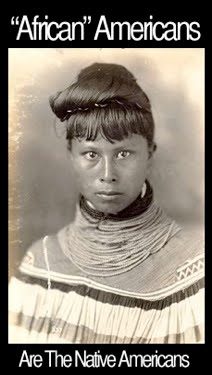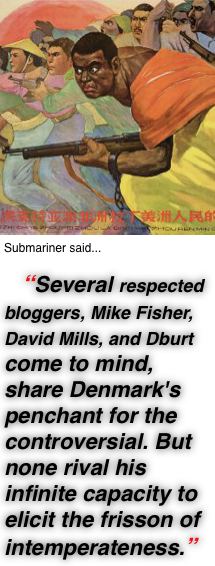Here in the United States, well over 95% of the 27 to 30 million people of African descent are Christians and they joined most of the rest of the Christian world in observing the birth of Jesus on December 25, Christmas Day. No other historical figure has received the recognition, veneration and unquestioned loyalty of Black people in the Western world that Jesus has. Yet, despite their widespread respect for and worship of Jesus, few Black people in the Americas or elsewhere ever have raised the question of whether He was Black and whether the doctrine He espoused was of African origin.
Trained by white theologians or taught in White owned, controlled or financed seminaries, the average Black minister will not only deny that Jesus was a black man and claim that it is sinful to raise the question of His color, but also will insist that Jesus was colorless and declare that the blue- eyed blond painting of him hovering over the minister's pulpit is just a White reflection of Christ's universality. It is quite understandable, then, that the masses of Black Christians, who generaLly hold their ministers in high esteem, blithely continue to bow before, pray to and worship a blue-eyed blond stranger whom they have come to know as Jesus without ever questioning this image and its impact on them, their families and the Black race as a whole.
Recognizing the historical significance of religion to Black people and observing its present role in their nations and communities the world over, this writer feels that it is high time that the deeply-rooted religious beliefs of Blacks be fully examined by Black scholars with an eye toward freeing the race of false doctrines and misconceptions that were designed to perpetuate Black inferiority and servility. Since religion plays a key role in molding Black opinion and guiding Black behavior in Africa and the diaspora, the specific intent of this article on religion, is to reveal what modern science is proving each day - that the roots of all major religions are traceable to the Black people of ancient Africa and that most of the world's venerated religious leaders were Blacks. It is hoped that these revelations will instill a sense of pride in Black people, hasten the day when false images will be removed from their houses of worship and free them of the widespread assumption - which is deeply embedded in their individual and collective subconscious - that they are cursed and doomed to failure because they were not created in God's image.
Professor Locksley D.M. Geoghagen is one of the few black authorities on the origin of the Christian religion. A scholar of African-Jamaican ancestry, he has served as the Associate Director of the Educational Opportunities Program and a teacher in the Education Department at Cal Poly College, San Luis Obispo, California. He is a learning specialist with expertise in brain physiology, especially the cerebral hemisphere, and has teaching credentials on the community college level in psychology, education, political science, counseling and pupil personnel. Professor Geoghagen is also the coordinator of Leadership Programs at Cal Poly College.
A rare pluridisciplinary scholar, Professor Geoghagen has lectured broadly on subjects that range from melanin and the pineal gland to the African roots of civilization. He has often lectured with the distinguished author and scholar, Dr. Donald Cheek, and has traveled extensively, especially in Africa, with the world renowned historian, Dr. Yosef ben-Jochannan.
Professor Geoghagen has completed the course requirements for the Ph.D. in education at the University of California at Santa Barbara, and he plans to soon enter the field of Egyptology as an understudy of Dr. ben-Jochannan, Professor Geoghagen's expertise on early Christianity has been acquired over the past ten years, during which time he has engaged in research, lecturing and writing in the United Sates, the Caribbean and Africa.
The following is an interview with Professor Geoghagen on religion in general and the ancestry of Jesus in particular.
MAAT: Professor Geoghagen, why don't I just start with the question before us: Was Jesus a Black man?
Geoghagen: Yes, unequivocally and beyond a shadow of doubt, Jesus was a black man and there is much evidence to substantiate this. However, before I discuss this evidence, I would like to consider in some detail who Jesus was and to focus on the history of Christianity because Jesus' blackness will not be fully understood or accepted without this background.
MAAT: Okay, just who was Jesus?
Geoghagen: That is a very difficult question to answer, for Jesus was and still is many things to many people. To Christians he is a part of the Godhead, the Son of God, the Son of Man, the Prince of Peace, the Word made flesh, the messiah of Jewish expectations. Hence, through his trials, sufferings, temptations, death and resurrection, He provides for the remission of sins, redemption and life eternal for those who follow his teachings and accept him as their personal savior. To me, he is one of the world's 16 crucified saviors -- the last of them, I might add - whose lives fit an almost identical pattern from the time of Horus in 4100 B.C. (according to the most ancient beliefs, he was the first crucified savior) to the time of Judas Christas (Christ the anointed) in the pre-Christian era. In essence, the life that Jesus purportedly led, the activities in which he engaged, his teachings, his trials and sufferings and eventual death and resurrection, are identical to those of Horus and Osiris (two ancient Egyptian gods) and the other 14 crucified saviors. This point of view or revelation, though potentially shocking to the mass of believers, is nevertheless common knowledge to scholars. So Jesus and the belief system that he represents are thus a reappearance of one of the most beautiful ideas of the ancient black Africans of Ta-Merry - now called Egypt - which represented the eternal Father by the ever- coming Son, as in the Child Horus. This was the child of a mother who was the eternal virgin. The doctrines of the Incarnation, i.e., the word made flesh: the virgin birth, the resurrection, the Father-God who is identical to his own son and other doctrines (believed to be specifically Christian) were Egyptian long before there was even the concept of Adam and Eve, Judaism, Christianity and Islam.
MAAT: Are you saying that Christianity as a religion had its origins in ancient Egypt?
Geoghagen: Yes. In addition to what I have just stated, in the Eschatology of the Egyptians is found a trinity and a unity, and the Egyptians believed in punishment as well as everlasting happiness. Not surprisingly, then, the doctrine of everlasting life and the belief in the resurrection of the "Spiritual Body" are, according to Dr. Albert Churchward(author of Signs and Symbols of Primordial Man, Origins of Freemasonry, The Origin And Evolution of Religion, The Origin And Evolution of The Human Race, etc.) "the brightest and most prominent features of the Egyptian religion, and this we find was their belief before the time of the first king of the first dynasty." The general teachings and cosmological world view of the Egyptians eventually filtered down and provided the foundation for later so-called 'Western Religions,' i.e., Judaism, Christianity and Islam. This point is thoroughly documented by the brilliant and prolific African scholar, Dr. Josef ben-Jochannan, in an epic work, African Origins of the Major Western Religions. These teachings were handed down to the Essenes (a mythical Jewish sect in pre-Christian times) who were responsible for the development of many of the teachings and concepts attributed to Jesus.
MAAT: Are you suggesting, then, that Jesus was an Essene?
Geoghagan: There is no doubt in my mind that Jesus was an Essene. Essene doctrine is directly traceable to its African-Egyptian roots. In short, Jesus was one of the world's 16 crucified saviors whose beliefs and teachings were founded on the doctrines and principles of the ancient African Mystery System, and the events of his life directly parallel those of Horus (the first crucified savior), who lived at least 4100 years before Christ. For example, Horus was born of a virgin (immaculate conception), he disappeared at age 12 and reappeared at 30; he died at age 33 and descended into Hell. On the third day, he arose again and ascended into Heaven to sit on the right hand of his father, etc. Horus was cut into 14 pieces; Jesus was stabbed fourteen times. Horus' mother could find only one piece of him, his penis, and so she built obelisks in his memory. Jesus had the same phallic symbol associated with him, i.e., he had no sexual relations (at least after the conference of Nicene in 325 A.D.). So as you can see, Jesus and the other world saviors are copies of Horus. Their biographical facts are the same; only the names have changed.
MAAT: Are there parts of Jesus' life that are generally unknown to the public?
GEOGHAGEN: Yes, much if not most of the facts surrounding his life are absolutely unknown to the general public. To be specific, there is a twenty-one year period of his life that is completely unaccounted for in the Gospel. These 21 years, I would argue, are of critical importance in understanding who Jesus was as well as the source, inspiration and eventual development of his message and ministry. The fact is that not only Jesus but also John the Baptizer and some of Jesus'disciples were taught, by Egyptian priests, some of the fundamentals of the African Mystery System which later, through adaptations and distortions, became the foundation for what is now known as Christianity in its various forms and manifestations. The fact that Jesus was an initiate in the African Mystery System; that Jesus was taught and did study at various subsidiary lodges of the Grand Lodge of Luxor in Africa and elsewhere (i.e. Tibet, India, etc.) The fact that it was in Africa that Jesus became acquainted with the Essenes, who were largely responsible for much of the teachings credited to Jesus.
MAAT: You keep mentioning the ancient African Mystery System.Can you briefly tell us what this was?
Geoghagen: Basically, the African Mystery System was the educational system of Africa. It was called a 'mystery' by E. Budge, the Famous Egyptologist, and other Egyptian scholars; but it was not a mystery to Africans. It encompassed many branches of knowledge, including all of the sciences, philosophy, physics, all of the liberal arts and, of course, religion and metaphysics.
The foundation of that which was later called Greek philosophy comes directly from the African Mystery System. If an individual wants confirmation of this, he can consult such books as G.M. James' Stolen Legacy, B.D. Alexander's History of Philosophy, Alfred Weber's History of Philosophy, William Turner's History of Philosophy and Zeber's History of Philosophy.
Included as a part of the ancient African Mystery System were the major beliefs contained in the so-called 'Western Religions' of Judaism, Christianity and Islam. For those who want a closer look at this, I would recommend the Egyptian Book of the Dead and The Ancient Mysteries by C.H. Vail. Another book which provides great detail is Albert Churchward's Signs and Symbols of Primordial Man. It lays out all of the Hebrew, Christian and Hindu doctrines that come directly from the African Mystery System. A comparable book, also written by Churchward, is Origin And Evolution of Religion.
MAAT: Speaking of references, do you have any sources that support your shocking revelations concerning the life of Jesus?
Geoghagen: I most assuredly do. The details of Jesus' life from ages 12 to 33 are documented in the Aquarian Gospel of Jesus The Christ by Levi. It gives an account of Jesus' interaction with his African masters and the teachings which they bestowed on him. Further, it documents the travels of Jesus from Africa to India and his eventual return to Africa; and confirms how Jesus acquired his cosmological world view in the process. The World's Sixteen Crucified Saviors by Kersey Graves documents much of what I've said thus far. Stolen Legacy by George G.M. James, The Kione Bible (the original new testament written between ca. 50 A.D. - 100 A.D.). Anacalypsis by Godfrey Higgins, The Black Messiah by Albert Cleage Jr., and Jesus and The Zealots by S.G.F. Brandon, The Apocryphal New Testament by M.R. James, Rahids' Aquarian Gospel (another portion of the books removed from the Bible). The Secret Books of the Egyptian Gnostics by J. Doresee. There are literally hundreds of references to back up what I have said, including the work of Gerald Massey, E.A. Wallis Budge, Joel A. Rogers, Albert Churchward and, of course, the works of Yosef ben- Jochannan. These references that I have given will allow interested scholars and individuals to begin to scratch the surface of the wealth of material that is available on this subject.
MAAT: You keep mentioning the Essenes and the fact that Jesus was somehow connected with them. Who are the Essenes and have there been Any scientific or archaeological discoveries that document their existence?
Geoghagen: A large portion of 'Western Culture' is indebted to a little known secret cult (a direct offshoot of the African- Egyptian Mystery System) which was called Essene, among other names. This cult of Hebraic people has been identified by their occupation, geographical location, forms of worship and peculiarities of faith. They have been variously known as The Baptizers, The Third Sect, Men of Essa, The Mystery Sect, The Seers, The Pious, The Associates, The Apron Makers, The Propheciers, Seekers Of The Prince of Righteousness, The Essenes and The Ossenes. Ancient documents indicate some of the earliest Essene origins. Pliny the Elder (70-77 A.D.) called them the Hessenes. Josephus (6-8 A.D.) labeled them the Essenes. The same term was later used by Chrysostam, Eusebius, Porphery, Hippolytus, and many other ecclesias and chroniclers. Many of the descriptions given by these writers, particularly Eusebius and Pliny, depict the Essenes as an 'awesome, ascetic, pietistic sect which might be viewed as the forerunner of today's 'mod' communities.' This quotation is from Jesus Christ Super Psychic by T.N. Tiemeyer. Anyway, these and many other ancient references to the Essenes were fragmentary, distorted and often inaccurate. For example, ancient writers reported that the Essenes "lived without women, having renounced all sexual love."
Yet recent diggings in their ancient cemetery have so far unearthed a number of female skeletons. Greek and Roman historians also failed to discern the religious and mystical element which were basic to Essene thought.
MAAT: But what is their relationship to Jesus and what evidence do you have to support it?
Geoghagen: Like you, my primary concern with the Essenes is the relationship of their Order of Sect, and how, through their guidance and direction, Jesus was able to develop his own spiritual talents. For countless centuries, scholars have suggested that many of the teachings attributed to Jesus were very much influenced by the teachings of the Essenes. No doubt the expression of such a viewpoint subjects one to declarations of heresy by those in orthodox church circles. In other words, to even suggest that any part of the message of Jesus is or was less than original with Jesus is, no doubt, heresy. But, heresy or not, the historical facts speak for themselves. The discovery of the Dead Sea Scrolls by a young Bedouin, Mohammad el-Deeb, in 1945, did much to shed some light on this controversial topic. These scrolls were discovered in the northwest part of the Dead Sea Valley near Jericho in a series of caves on the edge of a valley named Wali Qumran. In the entire twentieth century, no discovery has had a greater impact on Biblicists, theologians and Judea-Christian exponents than the discovery of the Dead Sea Scrolls. Most scholars greeted the news with exultation. Such was not the case, however, for orthodox Christian believers in Jesus as "the only begotten Son of the Father." Hence, their response to the discovery of the scrolls and its implications was less than joyful. Ancient prophets, such as Isaiah, Moses and Zacharia, had predicted the coming of "the Messiah," "the Holy One of God," "the Prince of Peace," etc. And, early Bible authorities were aware that the Essenes had prophesied the coming of a "teacher of righteousness." It was naturally assumed that this was a term equivalent to those in the scriptures and that Jesus was the fulfillment of the Essene prophecies as well. But the Dead Sea Scrolls revealed that by the time of Jesus, the "teacher of righteousness" had already come and gone. Compounding this is the fact that the Dead Sea Scrolls were a source of further embarrassment to scholars of Biblicism because many of the sayings attributed to Jesus as original are found in the Essene records. Among the expressions and sayings generally claimed by Christians as original with Jesus, but yet contained in the pre-Christian Essene records are:
"Peace on Earth and good will to men," "You are the salt of the earth; you are the light of the world." "The thirst for righteousness." "The kingdom of God." "The Sons of light and the Children of darkness."
These are just a few. In addition, I would like to paraphrase from T.N. Tiemeyer's Jesus Christ Super Psychic. Rev. Tiemeyer states that the Dead Sea apocalyptical scrolls and The Book of Enoch, which were found in the caves of Qumran, beyond a shadow of doubt, have been dated before Christianity. However, these writings contain numerous phrases and concepts similar to those in the Sermon on the Mount. Also a list of selected Essene sayings compared to the Beatitudes of Jesus are remarkably similar. Tiemeyer goes on to say that: "obviously the best explanation is that Jesus was taught in the training schools of the Essenes." The evidence also points to New Testament persons as disciples of this same cult. The Bible descriptions of John the Baptizer, his life and personal habits conform to the practices of the Qumran community. Again in my mind there is little doubt but that Jesus was an Essene who espoused Essene doctrine which originally came from the teachings of the African Mystery System and were later incorporated as part of the foundation of Christian thought.
MAAT: Now that you have made these astounding revelations concerning the life of Jesus and the origins of his teachings, let us return to our original question: Was this figure of world renown a Black man? And, if so, are there any paintings, statues or icons that portray him as such?
Geoghagen: Indeed, Jesus was a Black man, and there are numerous early paintings, statues and icons that graphically depict both Mary and Jesus as Black people. According to Godfrey Higgins (author of the monumental historical document Anacalypsis), who visited the cathedrals of Europe before the anti-religious period of the French Revolution, all the madonnas and Christ-childs were depicted as black: "In all the Romish countries of Europe, in France, Italy, Germany, etc., the God, Christ, as well as his mother are described in the old pictures to be black. The infant God in the arms of his black mother, his eyes drapery white, is himself perfectly black. If the reader doubts my words, he may go to the cathedral of Moulins - to the famous chapel of the Virgin of Loretto, to the Church of Annunciata; the Church of St. Lazaro, or the Church of St. Stephen at Genoa, to St. Francisco at Pisa; to the Church of Brixer in the Tyrol, and that of Padua; to the Church of St. Theodore at Munich, etc. This is further supported and documented by the work of J.A. Rogers, Albert Churchward, Yosef ben-Jochannan, C.W. King, J.S. Matthews, Gerald Massey and various other writers who give detailed accounts of the original Black Mary and Jesus. It was with the advent of Michaelango, who used his family to pose for the paintings that he did of Jesus, Mary, Joseph, etc. - coupled with European white racism - that we begin to see Jesus portrayed as a white man. But how could it be otherwise? How could a group of people simultaneously proclaim and practice white racism and justify slavery under the guise of bringing the message of Christianity to the 'heathens' or 'pagan black savages' in Africa - and at the same time tell the truth that Jesus was a Black man and that in fact Christianity started in Africa, where Panteus and Boteus reported that Jesus was born in a cave in Ethiopia? And that it was not until the Nicene conference that Jesus' birthplace was changed to a stable in Bethlehem.
MAAT: This is the second time you have mentioned the Nicene Conference. Where was this conference held? What was it about? And who attended it?
Geoghagen: There were two councils of the Christian Church held in Nicea (Nice), in what is now northwest Turkey. The most important was called in 325 A.D. by Constantine "the Great" and 219 bishops from all of the powerful Christian regions attended it. It was the intent of Constantine to change Christianity into Christiandom. In other words, religion would now become the vehicle of government control over the people. Achievement of this goal involved changing some of the tenets of Christianity. Anyone who is interested can obtain a copy of the proceedings of the Nicene Conference and see the tremendous political struggle that was going on between the "Men of God."
One will notice that at least 18 books - including the book of Mary - that were part of the Koin Bible (the original Bible up to that point) were removed from the canons. Furthermore, many of the ancient African teachings, including the concept of reincarnation, were removed from Christianity. And it was at this time that they put into the new Bible the ancient African concept of the Immaculate Conception.
MAAT: Are you literally saying that the original Bible was changed at the Nicene Conference?
Geoghagen: Yes. But this was not the first time that Church leaders had gotten together to fight over what was to be accepted as Christianity. A similar conference was held in Jamnia in A.D. 90, at which time other changes were made.
MAAT: Getting back to the questions of whether Jesus was a Black man: Some scholars, of course, would challenge your position that Jesus was a black man on the ground that he was Jewish and could not therefore have been Black.
Geoghagen: My opinion is that those would be very misinformed scholars because the original Jews were Black people.
MAAT: Some scientists today might also raise the point that the ancient Shroud of Turin, which has been highly touted by the press and which many now claim bears the image of Jesus, does not appear to depict a Black man. What would be your response to this?
Geoghagen: It would be of little consequence as to whether the shroud of Turin appears to be Black, Asian, Caucasian or whatever, because the only thing that scientists are able to determine at this point is that indeed this probably was a shroud that covered a human body and does not appear to be fake.
But no Scientist alive of whom I am aware - racist or nonracist, Christian or non-Christian - can in any way, shape, form or fashion document that the Shroud of Turin is the one that was placed over Jesus' body at the time of his death.
MAAT: Was Jesus the only great religious leader who was Black?
Geoghagen: Absolutely not. Most of the ancient prophets and saviors of most religions were depicted in their original form as Blacks.
MAAT: If all of these ancient prophets, gods and goddesses were Blacks, does this suggest a universal Black dominance in the ancient world?
Geoghagen: Most certainly, yes. One might read Gerald Massey's Egypt: The Light of the World, from archaeological and anthropological evidence alone, there is no doubt that the race of Black people was the seed race for humanity. In other words, we were here before anyone else and our presence was felt and known throughout the world.
We not only occupied Africa, but our remains have been discovered from the Fiji Islands to Tasmania, Melanesia, India, China, Japan, Mexico and even Europe. Many scientists have shown that the original race of people in all of these areas was the Black race.
MAAT: Why is it that the facts that you have revealed here are unknown to the general public?
Geoghagen: They are intentionally kept from the public. You take a situation where you have a group of people - namely white people - who have actually taken philosophy, religion, education, science, liberal arts, everything that you can associate with the word "culture" from Black people. They have taken it, distorted it, adopted it and used it against the very people from whom they received it as a justification for slavery. So, it was convenient to enslave Blacks in Africa under the guise of spreading Christianity when it fact the religion as developed in Africa (there were 27 bishops and seven Popes of the North African Church before the first one in Rome - this is documented in the book Libers Pontificals, which, when translated into English, is Book of the Popes). I should also point out here that few references are made to the fact that three of the earliest fathers of the Christian church were Blacks. St. Augustine (born at Tagaste, Numida, North Africa in 354 A.S.), who set the moral doctrine of the Christian Church; Tutillian and Cyprian. How could white people tell Blacks that they had no history or culture other than that which Europeans gave them and at the same time tell them that Christianity was not only developed by Blacks, but that its master, Jesus, was a Black man? This could not be done.
MAAT: Why do you think that it is important for Black people to know that Jesus was a Black man and that Christianity is of African origin?
Geoghagen: I feel that this information is critical to the self- esteem and future of Blacks around the globe. Our contributions as the originators of high culture or "civilization" have been systematically kept from us. Our inventions, our philosophies, our religious concepts and
systems have been stolen, co-opted, distorted, adopted and then used against us. We as a people must begin to assert ourselves and to reclaim our history and our science, and become knowledgeable about who we are, whence we came, and where we are going. Without a thorough knowledge and understanding of African history (including the development of Christianity in Africa), our future as a people is at best bleak. --------------------------------------------------------------------
Copyright 1997, Legrand Clegg II, All Rights Reserved
Wednesday, November 22, 2006
Subscribe to:
Post Comments (Atom)
















































































































1 comment:
Hello Brother Bijoy!
Welcome to the blog. Thank you very much for your kind words.
I am eager to review your series on the Essenes. I wish to learn as much as I can.
Best Regards,
DV
Post a Comment